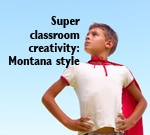
One of the troubling things about the film Waiting for “Superman” is that director Davis Guggenheim shows one teacher displaying one act of innovative teaching (using rap to teach math concepts) and implies that such creativity rarely happens in public schools.
But public school teachers are some of the most creative folks on the planet. MEA-MFT asked some of our teacher/members for examples of innovative teaching, and we
received dozens of replies. Below are a few of them.
What’s your classroom innovation? Let us know. E-mail [email protected]. Give your name, school,subject, grade(s) you teach and a brief paragraph about your creative method.
The Beaker Dance: Cheryl Plettner, science teacher at Helena Middle School, says, “Rap? Well, we do it one better. It’s called the Beaker Dance. To help students learn the names and uses of various pieces of scientific glassware, I have my students write a rap that includes the name of the glassware and its use. Students add physical movements and perform each for their classmates. We all laugh and have a good time, but the result is that students can tell the difference between a beaker and flask and how each one is used and get a little exercise in the process.”
Calamari Special: Plettner also offers this innovation: “When we are studying the different animal groups and dissecting to reveal external and internal structural differences, I have students dissect fresh and/or frozen food grade squid, octopus, clams, oysters, mussels, crayfish, crabs, even a lobster or two and anything else the guys at Ocean Beauty [a local seafood store] can order whole.
“The students seem to take a little more care with their dissecting when they know that what they’re dissecting will be food. Instead of throwing the specimens away when we’re done dissecting, the pieces are prepared (breaded, minced or other), cooked and served. We eat them! I invite parents in for the Seafood Fest, and the students show off what they have learned along with everyone having a good time. This helps with teaching external and internal parts of each animal along with a parent connection. Thank you, Ocean Beauty!”
Games in Espanol: Lynette Pottenger, Spanish teacher at Fort Benton High School, has her students play popular games in Spanish, such as Guess Who?, Battleship, Memory, Scattergories, and Pictionary.
She also has students play a “Whodunit?” game, which she describes thus: Each student is given a card with a “new” identity with name, origin, age, and telephone number. They are also given a list of all the “suspects” with their names, origins, ages, and telephone numbers. If you have 20 in a class, you will need 21 cards.
Pass out the cards to the students and tell them they need to figure out who the guilty party is. (The guilty person is the card you have left over. None of the students is guilty). The students’ job is to talk with everyone in the class (in Spanish), asking the questions: What is your name, where are you from, how old are you, and what is your phone number? Once they have eliminated everyone in the class, they should know the guilty party.
Pottenger uses this exercise with higher-level students by changing the information on the card, such as what the suspect is wearing, doing, etc.
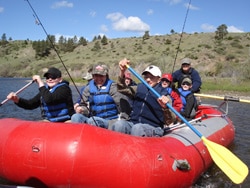 |
|
Float trips & service projects inspire “borderline” kids to keep up their grades and stay out of trouble. |
Teach a child to fish: Mike Kepler & Cheryl Plettner of Helena Middle School created the Conservation & Fishing Club to help students feel connected with the school and keep their grades up. “Many of our kids are not into sports, do not have straight A’s, and are not the wealthiest kids in the school,” says Kepler.
Club membership requires no failing grades or discipline referrals. “It’s a real driving force for some of our borderline kids,” Kepler says. With help from staff at the state Dept. of Fish, Wildlife and Parks, the club allows students to participate in fishing trips and service projects.
Good book hunting: Sue Lorang, school librarian in Miles City, invented a creative method to help her elementary classes learn how to use the library. “Since kids at our school are very familiar with hunting season, I write down call numbers on index cards,” she says. “I tell the kids this is their hunting license and they will be hunting for a book that matches that call number. They love the idea of having a hunting license, and they eagerly search for their book and clamor for more.”
Singing water cycle: Hilary Lozar, second grade teacher in Ronan, teaches the water cycle using the three learning styles: visual, auditory, and kinesthetic. “We practiced writing and spelling the words, we sang a song using all the words, and then we did motions for each word,” she says. “Then we put it all together: read, sing, dance.” In the process, Lozar learns each student’s preferred learning style, and students learn the water cycle.
Designing students: Darwin Feakes of Browning High School says, “I use a lot of technology to reinforce students’ computer aided designs. We print out posters of their designs, build scale models of their product/design, then manufacture the product with CNC Computer Numeric Controlled equipment such as a CNC router, CNC metal lathe, CNC plasma cutter, and we will be adding a CNC laser engraver that also cuts thin wood or plastics.”
Cell phones & quantum physics: Murray Metge, freshman science teacher at C.M. Russell High School in Great Falls, says he was discussing quantum physics in class one day and how it pertains to the atomic spectra. “Students had a glazed-over look and did not have much to say,” he says. So he had an inspiration: he asked students to get out their phones and had students with internet access work with those who didn’t. They then began researching quantum physics. “The students were really engaged,” says Metge. “I still do this and students enjoy using their phones in class.”
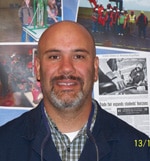 |
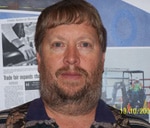 |
|
Grizz Biz gurus: Mr. Senger (top) and Mr. Volkmer |
Grizz Biz: Pat Volkmar and Derik Senger, industrial technology teachers at North Middle School in Great Falls, teach an entrepreneurship class called “Grizz Biz” (named after the school’s mascot). Students in this block-scheduled class run a for-profit business. They create their own laser items as well as taking in custom woodwork and engraving. They also create web sites for customers. Students elect a board of directors that sets into motion the business plan, employee rules and procedures, and policies. During the summer months, they operate stands at Farmers Markets and the State Fair. Check them out at GrizzBiz.com.
Shakespeare in a sock: Dakota Rosales, English teacher at Great Falls High School, does Sock Puppet Theater with seniors during her Hamlet unit. The students create their own noscripts to recreate the scene in the play they have selected. “The sock puppets were amazing, and the students LOVED it,” she reports.
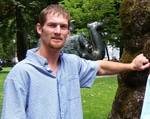 |
|
Chris Crocker |
Learning the elements: Chris Crocker, chemistry teacher at Great Falls High School, says, “I use a picture-story system for memorization of the periodic table. A letter and word are assigned to each single digit number from 0-9, and then these words and letters are used in combination to build quick stories that are associated with the numbers.
“Then the stories are altered to include the names of the elements on the periodic table. This is very effective and leads to more than 90 percent of all students learning the top 20 elements and their symbols. Not only do the students learn the elements, they also retain this knowledge year to year. The cool part is that using this system allows a student to recall any given number of elements instantly without having to sing a song or recite elements in order. It also associates the NUMBER to the element which is crucial in chemistry.”
Monk Day: Chris Nevinski, a band teacher at C.R. Anderson Middle School in Helena, created “Monk Day,” when the entire rehearsal is conducted with zero verbal communication from the band director. “This demands that students focus on physical gestures and visual communication instead of lengthy explanations,” Nevinski says. “If a student is chatty, she or he is told to be quiet by peers instead of an adult.”
Technology in music: Kevin Cleary teaches grades 6-8 orchestra, chorus, and general music in Helena. He and colleague Kelly Elder have a class set of iPods they use to access an online classroom during class time. “This allows students to engage with familiar technology and begin to see it as having more than just entertainment value,” Cleary says. “I also teach a unit with my general music class (called Music Tech) in which students design and create a commercial from scratch using the Mac iLife Suite. They get to learn about filming technique, video editing, composition, and variety of other skills while doing something fun and frequently silly.”
Tackling diabetes: Pamela Armstrong, a teacher in Browning, created a way to highlight National Diabetes Awareness Month. “The Native American population is greatly affected by diabetes,” she says. “They are at a high risk of becoming diabetic in their lifetimes.” To highlight the risk factors for her 4th, 5th, and 6th grade students, she presents a chart with red Xs to highlight various risk factors for diabetes: family member with diabetes, Native American, daily sugary treat, obesity, and inactive lifestyle.
Armstrong explains that this particular population of students already has two risk factors they can’t change: family member and Native American. Discussion then focuses on risk factors students can change. “I can say that this visual has made an impact on my students,” says Armstrong.
This magic moment: Barb Cooper, Spanish teacher at C.R. Anderson Middle School in Helena, says, “To alleviate test anxiety, every once in awhile, I give a ‘magic moment’ test. I tell the kids to read the entire test when they first get it, and then when they are about halfway through it, I tell them to leave their tests and pencils on their desks. They have exactly one minute to talk to anyone about the test. You have to watch the minute hand very closely so that it is exactly one minute. I count down from ten and when I reach 0, they’re in their seats and back to work.”
Cooper’s students also play basketball for review. “I tape a line on the floor and we use the garbage can for the basket and wadded paper for the ball. The kids are divided into teams and they come up with a captain, a team name, and a scorekeeper. I ask a question and if they answer correctly, they get one point and go to the free throw line. If they make the basket, it’s an additional point. The really hard questions are the three point shots (2 for the answer and 1 for the basket). They can pass up to three times, but the fourth person has to answer the question. It’s fun and it’s a great review.”
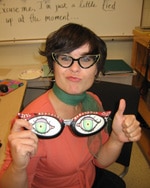 |
|
Erin Cleveland |
Fun & games with English: Erin Cleveland, English teacher at Capital High School in Helena, has created a variety of games where students have to use their vocabulary words verbally or written. She created the Race Game where students race in teams on the board to spell the words correctly first or write the definition/use in a sentence the first.
“We play Balderdash to learn words sometimes, or play Pictionary with the words,” Cleveland says. “I also have students use their words in a funny story with a partner that we read aloud, or they are assigned humorous skit ideas where they use words in dialogue and act them out for the class in groups.”
Hands-on science: Janet Goodell, science teacher in the Dutton-Brady Public Schools, uses a variety of creative methods to get her students involved in science. She takes her 8th graders to the gym and has them run, time themselves, and calculate their speed in meters/seconds so they can relate to speeds described in their physical science book.
This fall, she had her earth science students use GPS receivers to find hidden objects around town. Her chemistry students made Christmas decorations while doing and learning about a redox reaction.
“Every day I give all my students in 8th grade through 12th grade science a science question of the day,” she says. “They ask me if I forget. The same question goes to all with correct answers placed in a crock (vessel, not shoe). Each week a winner is drawn. He/she may select a prize from my treasure box. I know it sounds hokey, but they demand it! I give easy questions some day and hard ones others (I do have physics students and really smart 8th graders). At the end of the semester, I draw a name from among those who have been especially good at answering the question. They get to order a prize from Science Innovations, a great science toy company. I do this with my own money and fill my treasure box with freebies.”
Helena brainstorms: Jodi Delaney of Helena writes that the Helena Education Foundation web site has PDFs from the past nine years’ worth of Great Ideas Grant recipients. Visit http://hefmt.org/grants and scroll down to the Past Recipients on the right side. Delaney recently won a grant to purchase pedometers , “Step Up to Healthy Living.”
“I would also like to point out that Helena has one of the only K-12 media literacy programs in the nation, for public or private schools,” Delaney says. She also mentions that Helena has public school Montessori classes. “Instead of Montessori being available only in the private sector, our public school students can benefit from that philosophy while still being enrolled in our existent elementary schools (presently, we have Montessori ‘pods’ at three of the elementary schools). Delaney teaches an Intermediate Montessori (4th/5th grade) class right alongside traditional and multi-age classrooms. “We have a little of everything to offer students and parents options that will best fit their children,” she writes.
Students as teachers: Deb Johnson of Central School in Helena says, “One of the wonderful innovative opportunities for our students comes from Jerry McCarthy’s physics class at Helena High School. Every year, Jerry sends his students out in pairs to elementary schools to teach a physics lesson. Thankfully, I am on the receiving end of it every year and my students get to participate in one or more wonderful physics lessons. Often it is my former students who come back to teach the lesson. It has been my experience the lessons are well-planned and exciting. They are hands on and wonderful learning opportunities which increase my students’ knowledge and enthusiasm for science.”
Survivor: Shirley Chesterfield-Stanton, health enhancement & physical education teacher at Capital High School in Helena offers this creative approach, “Our freshman class does a team building unit called Survivor. It involves problem-solving physical challenges with your team. An example is Antidote Crossing using an 8’ x 12’ mat and a climbing rope: Your group is fleeing from a highly infectious airborne virus. You have the antidote.
“You know the antidote will work, but only if you are able to stay away from re-infection. You have just enough antidotes for one dose per person, which will save your group.
“No extra antidote is available. A spill will mean a lost life. Safety is on the other side of the river (represented by a blue mat) because air currents always blow toward the infected area. You must get the group and the antidote to the other side without spilling one drop. The river below is filled with alligators just waiting to eat. How do you get your group across without touching the river? The antidote may not be taken before you get across the river as it is not powerful enough to counteract the virus in an infected area. If a spill occurs, refill the container, wipe up and start over.
“Luckily for your group, a rope swing has been secured from a large tree branch — but how do you get to the rope? Hints: Do not drink antidote or place in your mouth. When successful with all ten challenges, try this with half of your group blindfolded.”
The BICEP team: Miyoko Fisher, a paraeducator at C.R. Anderson Middle School in Helena, says, “The BICEP team at CRA Middle School includes Kelly Elder, Betty Bisom, Emily Currier, Shannin Preshinger, and Mike Agostinelli. They used GPS in a geocaching fieldtrip that involved finding interesting facts about Helena history. This lesson encompassed all their subject areas: social studies, math, science, and language.” [BICEP stands for the initials of the teachers’ last names.]
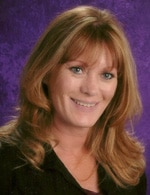 |
|
Shelli Lavinder |
Science in motion: Shelli Lavinder, chemistry/forensic science teacher at C.M. Russell High School in Great Falls, attended the National Science Teachers Convention where she learned to incorporate forensic science into other science areas: for instance; DNA analysis into biology class, or toxicology into a chemistry class.
Lavinder approached her principal with the idea of writing curriculum for a class in forensic science. With the support of her administration, she tackled this project. Her intent: write a curriculum where students would DO science more than memorize science; create a science class in which assessments would be something students participate in, not write down; provide a choice for a third science class (elective) for those not wanting the standard chemistry, physics etc.; and draw students not typically science-oriented into science with the popularity of shows like CSI, NCIS Criminal Minds, etc.
The curriculum is now a full-year class and has been accepted for dual credit with the University of Great Falls. The final for this class is probably the best example of doing science assessments: Students are put into teams of five or six. Typically on a Saturday, students willingly come in to process a mock crime scene. They get two hours to document and photograph each piece of evidence, measure the crime scene and all of the objects in it to create a scale drawing, and ultimately collect each piece of evidence.
Students then spend the next week processing the evidence as they were taught throughout the year. The last day, the team presents their findings to the class and special guests as though they were forensic experts testifying in court.
Potpourri: Trisha Klock at Helena High says, “Margaret Belisle and Jim Schultz (both at Helena High) are constantly finding ways to teach their concepts in a new way. Jim has the CSI class to help students who struggle in science to make it that much more interesting! Margaret constantly has students acting out plays, reading poetry out loud as a class, fingerprint vocabulary pictures, etc., the list is endless on both of them! They both have a very high success rate and wonderful relationships with students. Mr. Evans does an island project to help explain government concepts. His kids are always saying that the project was amazing and taught them a lot! I could go on about this for days…”
Inquiry method: Beth Murphy, science teacher at Capital High School in Helena, nominates her colleague, chemistry teacher, Paul Phillips for creativity recognition. “Paul has not only converted his chemistry classes into an inquiry method style, he has established training workshops for teachers in our district to learn and use inquiry method, too.” she says.
“When students seek and examine data, before being made to memorize vocabulary terms, they retain the concepts better. I’m an 8th grade science teacher, and now use inquiry with every unit. More importantly, Paul includes elementary teachers in the workshops, so they can use inquiry method and do more science in their classroom.”
Art & rhythm: Victor Daniel, art teacher at Helena Middle School, says, “I do a snowboarding project where students learn about graphic design. They form their own company, and design a logo. The snowboards also must illustrate the design principle of rhythm, and to introduce the concept I play the mandolin to the class and have them draw parallels between the musical concept of rhythm and the artistic concept.”
The UTEC writing method: Amanda Bestor, a young language arts teacher in Corvallis, helped revolutionize writing instruction school-wide. She offers this detailed example of her technique:
I was always struggling to get kids to write more, to provide a topic sentence and a conclusion, and to explain their answers. I frequently found myself repeating the often-used phrase, ‘Writing is thinking on paper.’ And as a new teacher, I was feeling the pressure of the standardized tests and their constructed response results bearing down on me.
In February of 2009, I began using a new writing format, and it has helped me explain my expectations more effectively and improved the learning that goes on in my classroom.
In January of that year, I was fortunate enough to see Nancie Atwell speak at a conference in Indiana. Mrs. Atwell is known for her work with Writer’s Workshop and her many books written on the subject. Her presentation was on her new book, Lessons that Change Writers. One of the many topics that caught my interest was Test Writing as a Genre, because in my middle school we teach reading and writing in genres. Within these genre studies we teach students that different genres are made up of elements that make them unique. In Nancie’s lesson, she recommends giving students samples from constructed response questions and answers, and asks students to pick out the common elements in the best responses. In theory, this could vary by state and the expectations for each test.
When I came home from the conference I was asked to present something I learned, and I felt that Test Writing as a Genre would be something that might be relevant. In preparation, I looked at samples and wrote out the elements of Test Writing as a Genre, which I came up with by looking through the released samples of constructed response questions for the Montana CRT tests.
The problem with these elements is that they represent one more way that we sometimes present too many abstract concepts to students. I began to think about the importance of condensing the information into an easily remembered acronym. After all, acronyms had saved me more than once as a student in school. Many students are already familiar with PEMDAS and its reminder about the order of operations. I played around with acronyms, and that was how UTEC was born. You can rearrange the letters to spell CUTE, which is easier for middle school kids to remember, but this puts the order of elements, well out of order, so UTEC it is.
Use your space!
Topic sentence
Explain using specific details
Conclusion
To teach UTEC, I explain the importance of organizing your ideas and showing the reader what you as a writer knows. I then show them some samples of UTEC responses that I have written as an example, following this up with a question that they answer in UTEC format. As they complete their answers, I walk around the room and quickly read their responses as they finish up. This allows for immediate feedback and correction. It’s also a formative assessment that helps me to see who is struggling the most. I remind them about the conclusion or adding more details and praise them for what they’ve done correctly. They must make all changes before I accept the paragraph as complete. After a few days of paragraph-long UTEC responses, they have it. From then on I ask questions and just ask for the answers in UTEC format and they remember.
In the middle school where I work, I am lucky to have a very supportive principal and colleagues. They were all willing to give UTEC a try, and the results have been very exciting. Not only have we seen an increase in writing ability, but also in comprehension. One of the science teachers at our school has seen great results with UTEC. He uses the format in labs and for essay questions on his exams. It seems the format works well for high and low achieving students and increases their comprehension in the subject matter.
I have seen the same results in my own classroom. Accelerated students often write excellent essays, but they can forget topic sentences or conclusions and rarely support their ideas. Lower-achieving and special education students don’t write more than a sentence because they don’t know where to start. With UTEC, you are almost guaranteed a decent answer just by restating the question, referring to the text and tying your thoughts together with a conclusion. I believe it is the steps in this process that force students to see the question more concretely. They must ask themselves, “What is the question asking?” before they even begin their response.
Since then, I have used a giant form of UTEC for a five-paragraph research report, and it worked in the same way. The students were all familiar with UTEC, so I could expand the space into five paragraphs instead of just one. The topic sentence became an introductory paragraph and thesis. The specific details became three supporting paragraphs and the conclusion a closing paragraph. The results were the same because the framework for UTEC already existed. They were able to build off of that background knowledge and apply it to essay writing as well.
School wide, I think that UTEC has been a success, not because it is such a novel or creative idea, but because of the whole-staff buy-in. Students are expected to write in this way in every classroom, and this shows importance and value in complete, crafted answers. It also helps with the concept that organized, well thought out and concise writing is good writing in every subject, and after all isn’t it? I no longer battle students to write more, provide a topic sentence and a conclusion, or to explain their answers. If they come up short I just say, “You didn’t use UTEC, go back and see what you’re missing.”
